Kabul City Emergency Operation Plan: Disaster Response & Mitigation
VerifiedAdded on 2023/06/08
|13
|3312
|285
Report
AI Summary
This report outlines Kabul City's Emergency Operation Plan, designed to facilitate a comprehensive emergency management scheme. It details the roles and responsibilities of various city departments, agencies, and volunteer organizations in mitigating, preparing for, responding to, and recovering from natural and technological disasters. The plan emphasizes a coordinated, systematic approach to minimize loss and damage, preserve life, provide necessary assistance, and establish a recovery system to restore the community. It addresses potential hazards specific to Kabul, including meteorological events and terrorism-related incidents, and emphasizes the importance of local resource allocation before seeking state or federal assistance. The plan also describes distinct phases of emergency management: mitigation, preparedness, response, and recovery, with specific activities and responsibilities assigned to each phase. The Kabul City Emergency Operations Center (EOC) serves as the multiagency coordination system (MACS) for all emergencies, ensuring a maintained potentiality in responding to unexpected events. Finally, the report includes declaration procedures and the adoption of the Homeland Security Advisory System.

Running Head: EMERGENCY OPERATION PLAN
Emergency Operation Plan:
Student’s Name:
Institutional Affiliation:
Emergency Operation Plan:
Student’s Name:
Institutional Affiliation:
Paraphrase This Document
Need a fresh take? Get an instant paraphrase of this document with our AI Paraphraser
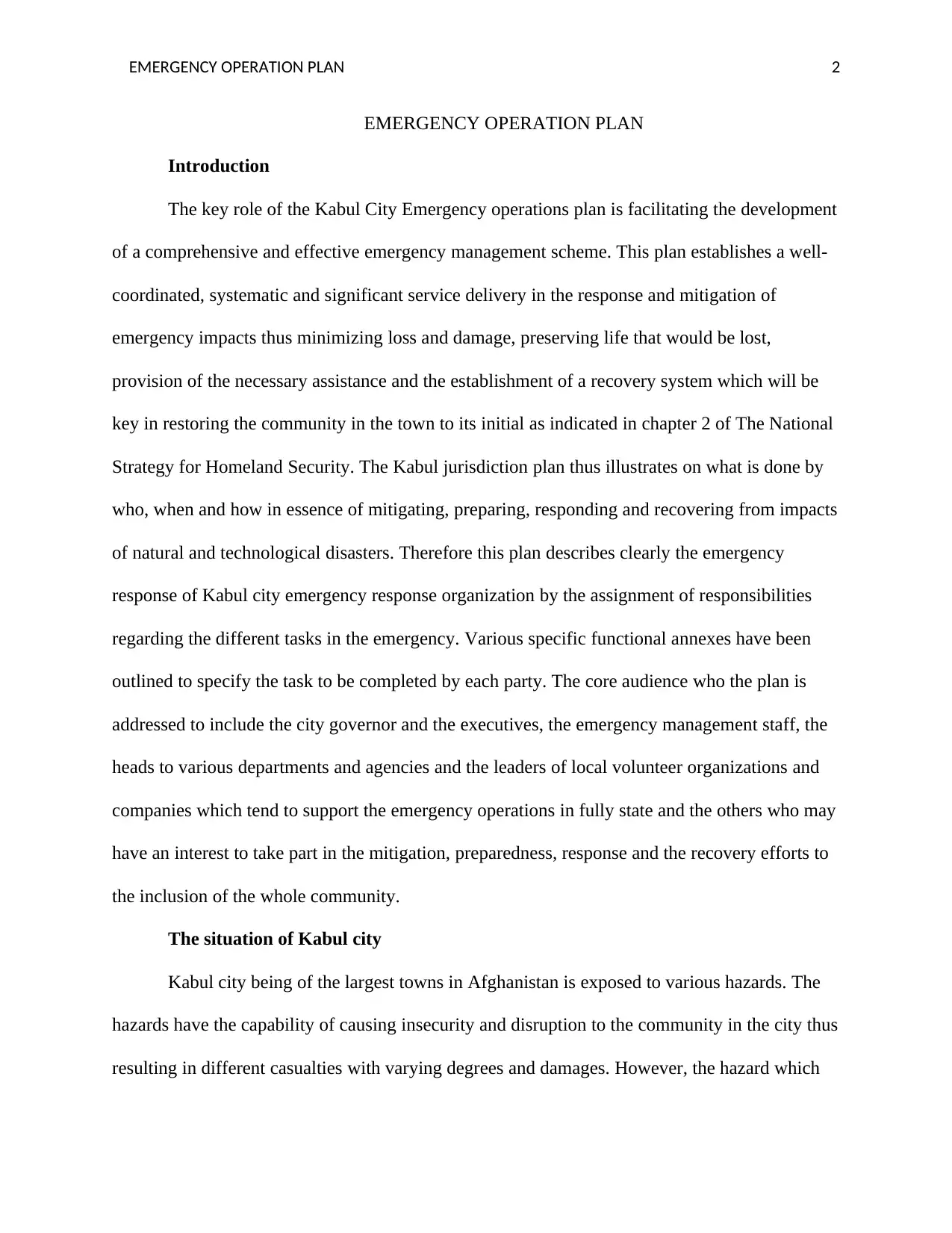
EMERGENCY OPERATION PLAN 2
EMERGENCY OPERATION PLAN
Introduction
The key role of the Kabul City Emergency operations plan is facilitating the development
of a comprehensive and effective emergency management scheme. This plan establishes a well-
coordinated, systematic and significant service delivery in the response and mitigation of
emergency impacts thus minimizing loss and damage, preserving life that would be lost,
provision of the necessary assistance and the establishment of a recovery system which will be
key in restoring the community in the town to its initial as indicated in chapter 2 of The National
Strategy for Homeland Security. The Kabul jurisdiction plan thus illustrates on what is done by
who, when and how in essence of mitigating, preparing, responding and recovering from impacts
of natural and technological disasters. Therefore this plan describes clearly the emergency
response of Kabul city emergency response organization by the assignment of responsibilities
regarding the different tasks in the emergency. Various specific functional annexes have been
outlined to specify the task to be completed by each party. The core audience who the plan is
addressed to include the city governor and the executives, the emergency management staff, the
heads to various departments and agencies and the leaders of local volunteer organizations and
companies which tend to support the emergency operations in fully state and the others who may
have an interest to take part in the mitigation, preparedness, response and the recovery efforts to
the inclusion of the whole community.
The situation of Kabul city
Kabul city being of the largest towns in Afghanistan is exposed to various hazards. The
hazards have the capability of causing insecurity and disruption to the community in the city thus
resulting in different casualties with varying degrees and damages. However, the hazard which
EMERGENCY OPERATION PLAN
Introduction
The key role of the Kabul City Emergency operations plan is facilitating the development
of a comprehensive and effective emergency management scheme. This plan establishes a well-
coordinated, systematic and significant service delivery in the response and mitigation of
emergency impacts thus minimizing loss and damage, preserving life that would be lost,
provision of the necessary assistance and the establishment of a recovery system which will be
key in restoring the community in the town to its initial as indicated in chapter 2 of The National
Strategy for Homeland Security. The Kabul jurisdiction plan thus illustrates on what is done by
who, when and how in essence of mitigating, preparing, responding and recovering from impacts
of natural and technological disasters. Therefore this plan describes clearly the emergency
response of Kabul city emergency response organization by the assignment of responsibilities
regarding the different tasks in the emergency. Various specific functional annexes have been
outlined to specify the task to be completed by each party. The core audience who the plan is
addressed to include the city governor and the executives, the emergency management staff, the
heads to various departments and agencies and the leaders of local volunteer organizations and
companies which tend to support the emergency operations in fully state and the others who may
have an interest to take part in the mitigation, preparedness, response and the recovery efforts to
the inclusion of the whole community.
The situation of Kabul city
Kabul city being of the largest towns in Afghanistan is exposed to various hazards. The
hazards have the capability of causing insecurity and disruption to the community in the city thus
resulting in different casualties with varying degrees and damages. However, the hazard which
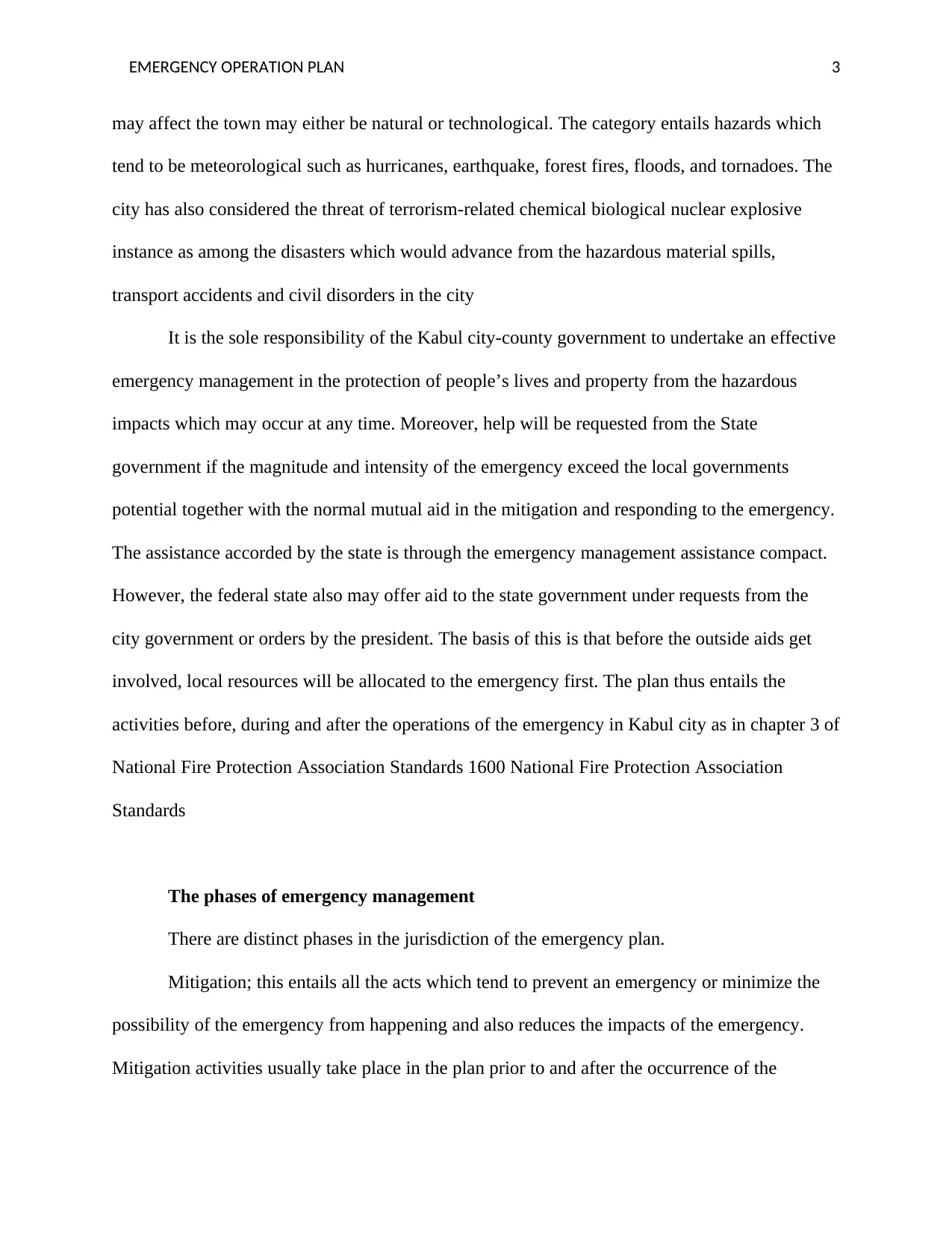
EMERGENCY OPERATION PLAN 3
may affect the town may either be natural or technological. The category entails hazards which
tend to be meteorological such as hurricanes, earthquake, forest fires, floods, and tornadoes. The
city has also considered the threat of terrorism-related chemical biological nuclear explosive
instance as among the disasters which would advance from the hazardous material spills,
transport accidents and civil disorders in the city
It is the sole responsibility of the Kabul city-county government to undertake an effective
emergency management in the protection of people’s lives and property from the hazardous
impacts which may occur at any time. Moreover, help will be requested from the State
government if the magnitude and intensity of the emergency exceed the local governments
potential together with the normal mutual aid in the mitigation and responding to the emergency.
The assistance accorded by the state is through the emergency management assistance compact.
However, the federal state also may offer aid to the state government under requests from the
city government or orders by the president. The basis of this is that before the outside aids get
involved, local resources will be allocated to the emergency first. The plan thus entails the
activities before, during and after the operations of the emergency in Kabul city as in chapter 3 of
National Fire Protection Association Standards 1600 National Fire Protection Association
Standards
The phases of emergency management
There are distinct phases in the jurisdiction of the emergency plan.
Mitigation; this entails all the acts which tend to prevent an emergency or minimize the
possibility of the emergency from happening and also reduces the impacts of the emergency.
Mitigation activities usually take place in the plan prior to and after the occurrence of the
may affect the town may either be natural or technological. The category entails hazards which
tend to be meteorological such as hurricanes, earthquake, forest fires, floods, and tornadoes. The
city has also considered the threat of terrorism-related chemical biological nuclear explosive
instance as among the disasters which would advance from the hazardous material spills,
transport accidents and civil disorders in the city
It is the sole responsibility of the Kabul city-county government to undertake an effective
emergency management in the protection of people’s lives and property from the hazardous
impacts which may occur at any time. Moreover, help will be requested from the State
government if the magnitude and intensity of the emergency exceed the local governments
potential together with the normal mutual aid in the mitigation and responding to the emergency.
The assistance accorded by the state is through the emergency management assistance compact.
However, the federal state also may offer aid to the state government under requests from the
city government or orders by the president. The basis of this is that before the outside aids get
involved, local resources will be allocated to the emergency first. The plan thus entails the
activities before, during and after the operations of the emergency in Kabul city as in chapter 3 of
National Fire Protection Association Standards 1600 National Fire Protection Association
Standards
The phases of emergency management
There are distinct phases in the jurisdiction of the emergency plan.
Mitigation; this entails all the acts which tend to prevent an emergency or minimize the
possibility of the emergency from happening and also reduces the impacts of the emergency.
Mitigation activities usually take place in the plan prior to and after the occurrence of the
⊘ This is a preview!⊘
Do you want full access?
Subscribe today to unlock all pages.

Trusted by 1+ million students worldwide
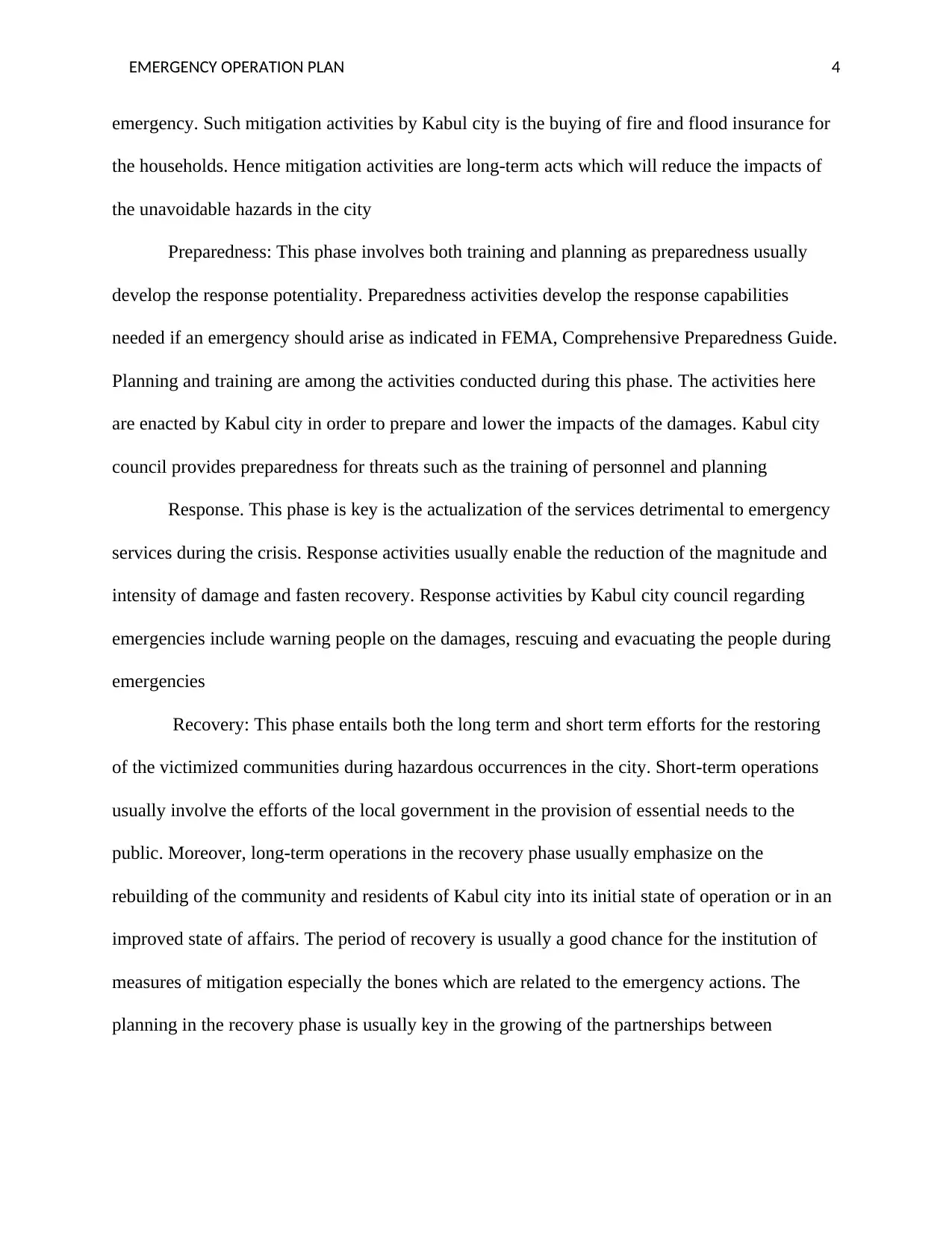
EMERGENCY OPERATION PLAN 4
emergency. Such mitigation activities by Kabul city is the buying of fire and flood insurance for
the households. Hence mitigation activities are long-term acts which will reduce the impacts of
the unavoidable hazards in the city
Preparedness: This phase involves both training and planning as preparedness usually
develop the response potentiality. Preparedness activities develop the response capabilities
needed if an emergency should arise as indicated in FEMA, Comprehensive Preparedness Guide.
Planning and training are among the activities conducted during this phase. The activities here
are enacted by Kabul city in order to prepare and lower the impacts of the damages. Kabul city
council provides preparedness for threats such as the training of personnel and planning
Response. This phase is key is the actualization of the services detrimental to emergency
services during the crisis. Response activities usually enable the reduction of the magnitude and
intensity of damage and fasten recovery. Response activities by Kabul city council regarding
emergencies include warning people on the damages, rescuing and evacuating the people during
emergencies
Recovery: This phase entails both the long term and short term efforts for the restoring
of the victimized communities during hazardous occurrences in the city. Short-term operations
usually involve the efforts of the local government in the provision of essential needs to the
public. Moreover, long-term operations in the recovery phase usually emphasize on the
rebuilding of the community and residents of Kabul city into its initial state of operation or in an
improved state of affairs. The period of recovery is usually a good chance for the institution of
measures of mitigation especially the bones which are related to the emergency actions. The
planning in the recovery phase is usually key in the growing of the partnerships between
emergency. Such mitigation activities by Kabul city is the buying of fire and flood insurance for
the households. Hence mitigation activities are long-term acts which will reduce the impacts of
the unavoidable hazards in the city
Preparedness: This phase involves both training and planning as preparedness usually
develop the response potentiality. Preparedness activities develop the response capabilities
needed if an emergency should arise as indicated in FEMA, Comprehensive Preparedness Guide.
Planning and training are among the activities conducted during this phase. The activities here
are enacted by Kabul city in order to prepare and lower the impacts of the damages. Kabul city
council provides preparedness for threats such as the training of personnel and planning
Response. This phase is key is the actualization of the services detrimental to emergency
services during the crisis. Response activities usually enable the reduction of the magnitude and
intensity of damage and fasten recovery. Response activities by Kabul city council regarding
emergencies include warning people on the damages, rescuing and evacuating the people during
emergencies
Recovery: This phase entails both the long term and short term efforts for the restoring
of the victimized communities during hazardous occurrences in the city. Short-term operations
usually involve the efforts of the local government in the provision of essential needs to the
public. Moreover, long-term operations in the recovery phase usually emphasize on the
rebuilding of the community and residents of Kabul city into its initial state of operation or in an
improved state of affairs. The period of recovery is usually a good chance for the institution of
measures of mitigation especially the bones which are related to the emergency actions. The
planning in the recovery phase is usually key in the growing of the partnerships between
Paraphrase This Document
Need a fresh take? Get an instant paraphrase of this document with our AI Paraphraser
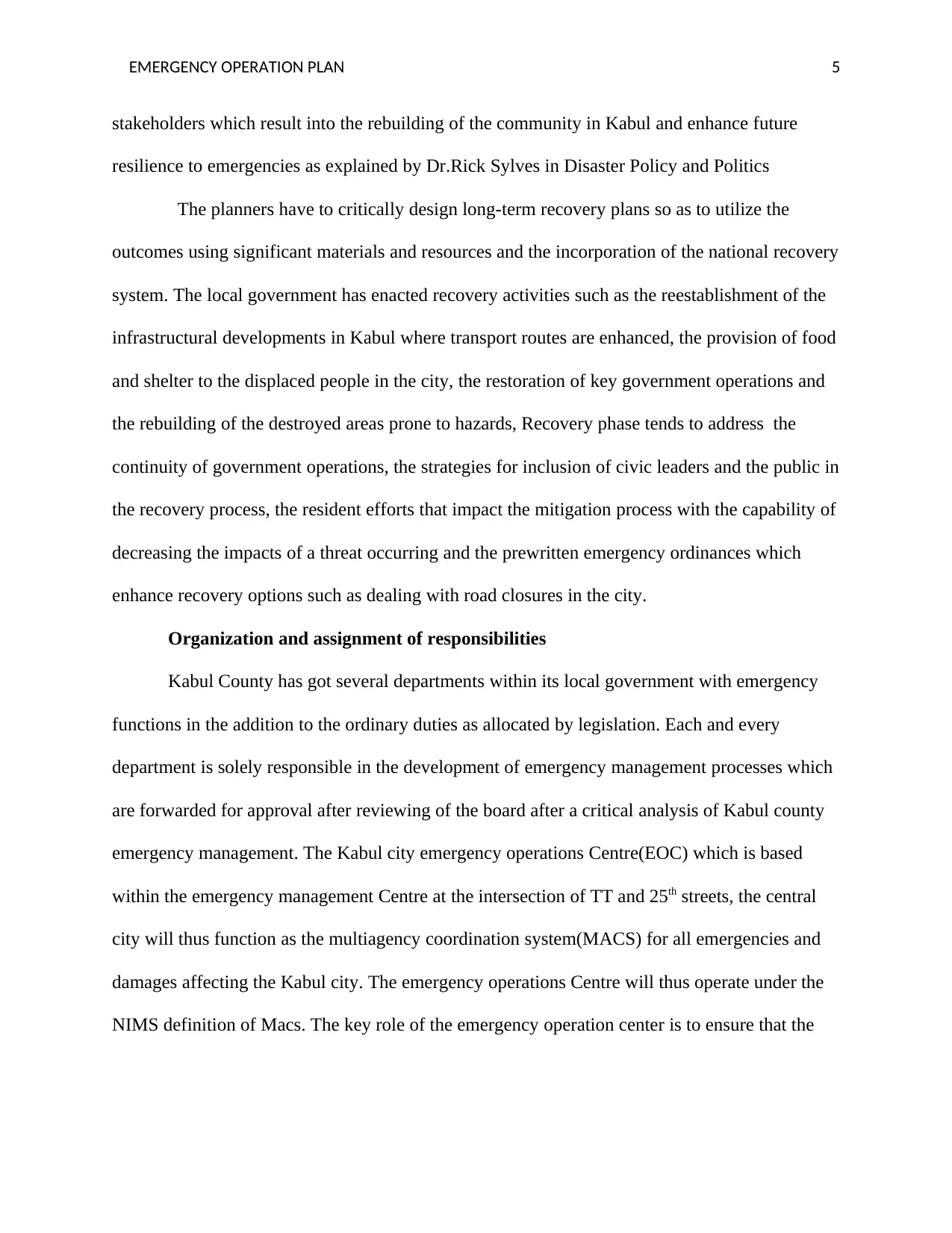
EMERGENCY OPERATION PLAN 5
stakeholders which result into the rebuilding of the community in Kabul and enhance future
resilience to emergencies as explained by Dr.Rick Sylves in Disaster Policy and Politics
The planners have to critically design long-term recovery plans so as to utilize the
outcomes using significant materials and resources and the incorporation of the national recovery
system. The local government has enacted recovery activities such as the reestablishment of the
infrastructural developments in Kabul where transport routes are enhanced, the provision of food
and shelter to the displaced people in the city, the restoration of key government operations and
the rebuilding of the destroyed areas prone to hazards, Recovery phase tends to address the
continuity of government operations, the strategies for inclusion of civic leaders and the public in
the recovery process, the resident efforts that impact the mitigation process with the capability of
decreasing the impacts of a threat occurring and the prewritten emergency ordinances which
enhance recovery options such as dealing with road closures in the city.
Organization and assignment of responsibilities
Kabul County has got several departments within its local government with emergency
functions in the addition to the ordinary duties as allocated by legislation. Each and every
department is solely responsible in the development of emergency management processes which
are forwarded for approval after reviewing of the board after a critical analysis of Kabul county
emergency management. The Kabul city emergency operations Centre(EOC) which is based
within the emergency management Centre at the intersection of TT and 25th streets, the central
city will thus function as the multiagency coordination system(MACS) for all emergencies and
damages affecting the Kabul city. The emergency operations Centre will thus operate under the
NIMS definition of Macs. The key role of the emergency operation center is to ensure that the
stakeholders which result into the rebuilding of the community in Kabul and enhance future
resilience to emergencies as explained by Dr.Rick Sylves in Disaster Policy and Politics
The planners have to critically design long-term recovery plans so as to utilize the
outcomes using significant materials and resources and the incorporation of the national recovery
system. The local government has enacted recovery activities such as the reestablishment of the
infrastructural developments in Kabul where transport routes are enhanced, the provision of food
and shelter to the displaced people in the city, the restoration of key government operations and
the rebuilding of the destroyed areas prone to hazards, Recovery phase tends to address the
continuity of government operations, the strategies for inclusion of civic leaders and the public in
the recovery process, the resident efforts that impact the mitigation process with the capability of
decreasing the impacts of a threat occurring and the prewritten emergency ordinances which
enhance recovery options such as dealing with road closures in the city.
Organization and assignment of responsibilities
Kabul County has got several departments within its local government with emergency
functions in the addition to the ordinary duties as allocated by legislation. Each and every
department is solely responsible in the development of emergency management processes which
are forwarded for approval after reviewing of the board after a critical analysis of Kabul county
emergency management. The Kabul city emergency operations Centre(EOC) which is based
within the emergency management Centre at the intersection of TT and 25th streets, the central
city will thus function as the multiagency coordination system(MACS) for all emergencies and
damages affecting the Kabul city. The emergency operations Centre will thus operate under the
NIMS definition of Macs. The key role of the emergency operation center is to ensure that the
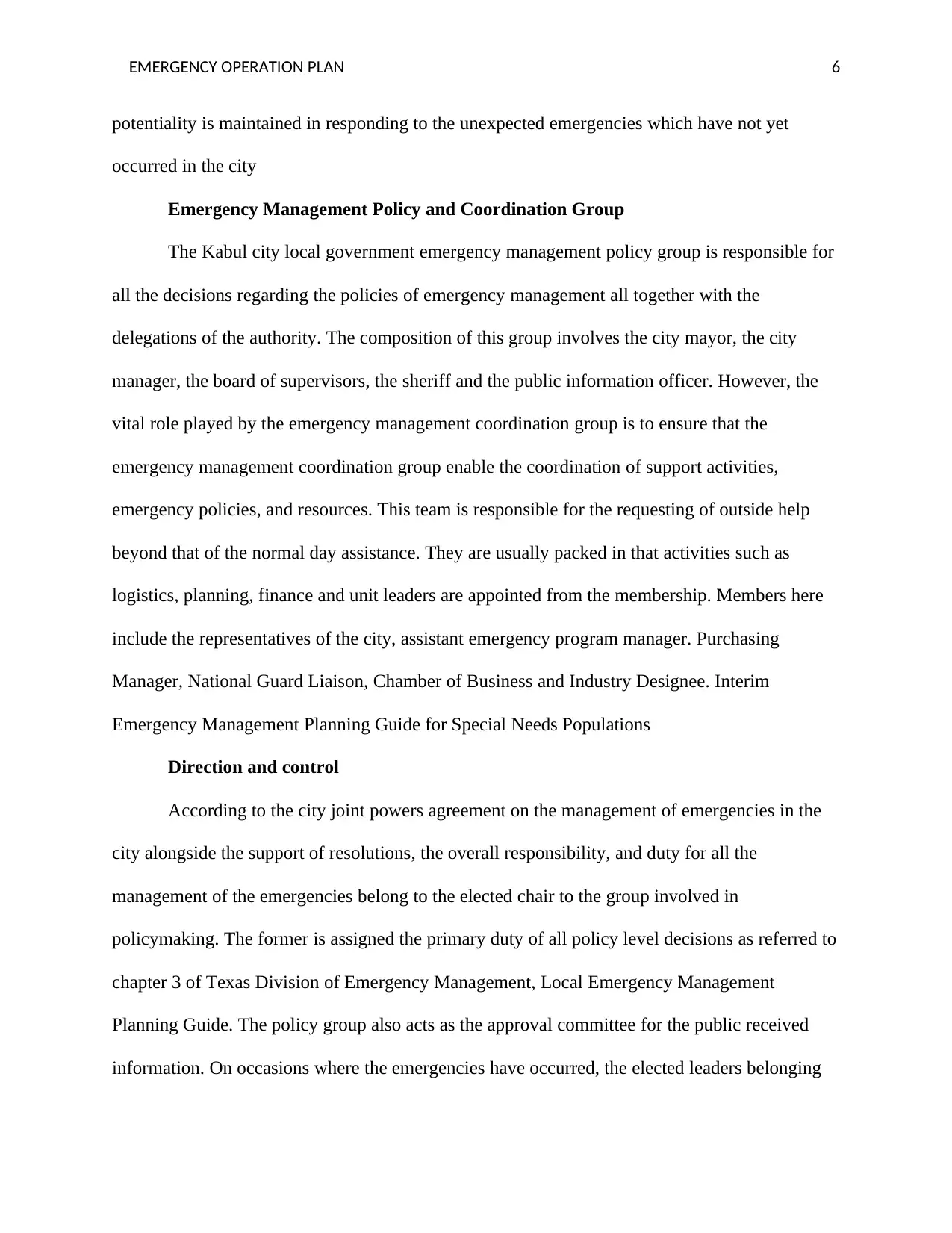
EMERGENCY OPERATION PLAN 6
potentiality is maintained in responding to the unexpected emergencies which have not yet
occurred in the city
Emergency Management Policy and Coordination Group
The Kabul city local government emergency management policy group is responsible for
all the decisions regarding the policies of emergency management all together with the
delegations of the authority. The composition of this group involves the city mayor, the city
manager, the board of supervisors, the sheriff and the public information officer. However, the
vital role played by the emergency management coordination group is to ensure that the
emergency management coordination group enable the coordination of support activities,
emergency policies, and resources. This team is responsible for the requesting of outside help
beyond that of the normal day assistance. They are usually packed in that activities such as
logistics, planning, finance and unit leaders are appointed from the membership. Members here
include the representatives of the city, assistant emergency program manager. Purchasing
Manager, National Guard Liaison, Chamber of Business and Industry Designee. Interim
Emergency Management Planning Guide for Special Needs Populations
Direction and control
According to the city joint powers agreement on the management of emergencies in the
city alongside the support of resolutions, the overall responsibility, and duty for all the
management of the emergencies belong to the elected chair to the group involved in
policymaking. The former is assigned the primary duty of all policy level decisions as referred to
chapter 3 of Texas Division of Emergency Management, Local Emergency Management
Planning Guide. The policy group also acts as the approval committee for the public received
information. On occasions where the emergencies have occurred, the elected leaders belonging
potentiality is maintained in responding to the unexpected emergencies which have not yet
occurred in the city
Emergency Management Policy and Coordination Group
The Kabul city local government emergency management policy group is responsible for
all the decisions regarding the policies of emergency management all together with the
delegations of the authority. The composition of this group involves the city mayor, the city
manager, the board of supervisors, the sheriff and the public information officer. However, the
vital role played by the emergency management coordination group is to ensure that the
emergency management coordination group enable the coordination of support activities,
emergency policies, and resources. This team is responsible for the requesting of outside help
beyond that of the normal day assistance. They are usually packed in that activities such as
logistics, planning, finance and unit leaders are appointed from the membership. Members here
include the representatives of the city, assistant emergency program manager. Purchasing
Manager, National Guard Liaison, Chamber of Business and Industry Designee. Interim
Emergency Management Planning Guide for Special Needs Populations
Direction and control
According to the city joint powers agreement on the management of emergencies in the
city alongside the support of resolutions, the overall responsibility, and duty for all the
management of the emergencies belong to the elected chair to the group involved in
policymaking. The former is assigned the primary duty of all policy level decisions as referred to
chapter 3 of Texas Division of Emergency Management, Local Emergency Management
Planning Guide. The policy group also acts as the approval committee for the public received
information. On occasions where the emergencies have occurred, the elected leaders belonging
⊘ This is a preview!⊘
Do you want full access?
Subscribe today to unlock all pages.

Trusted by 1+ million students worldwide
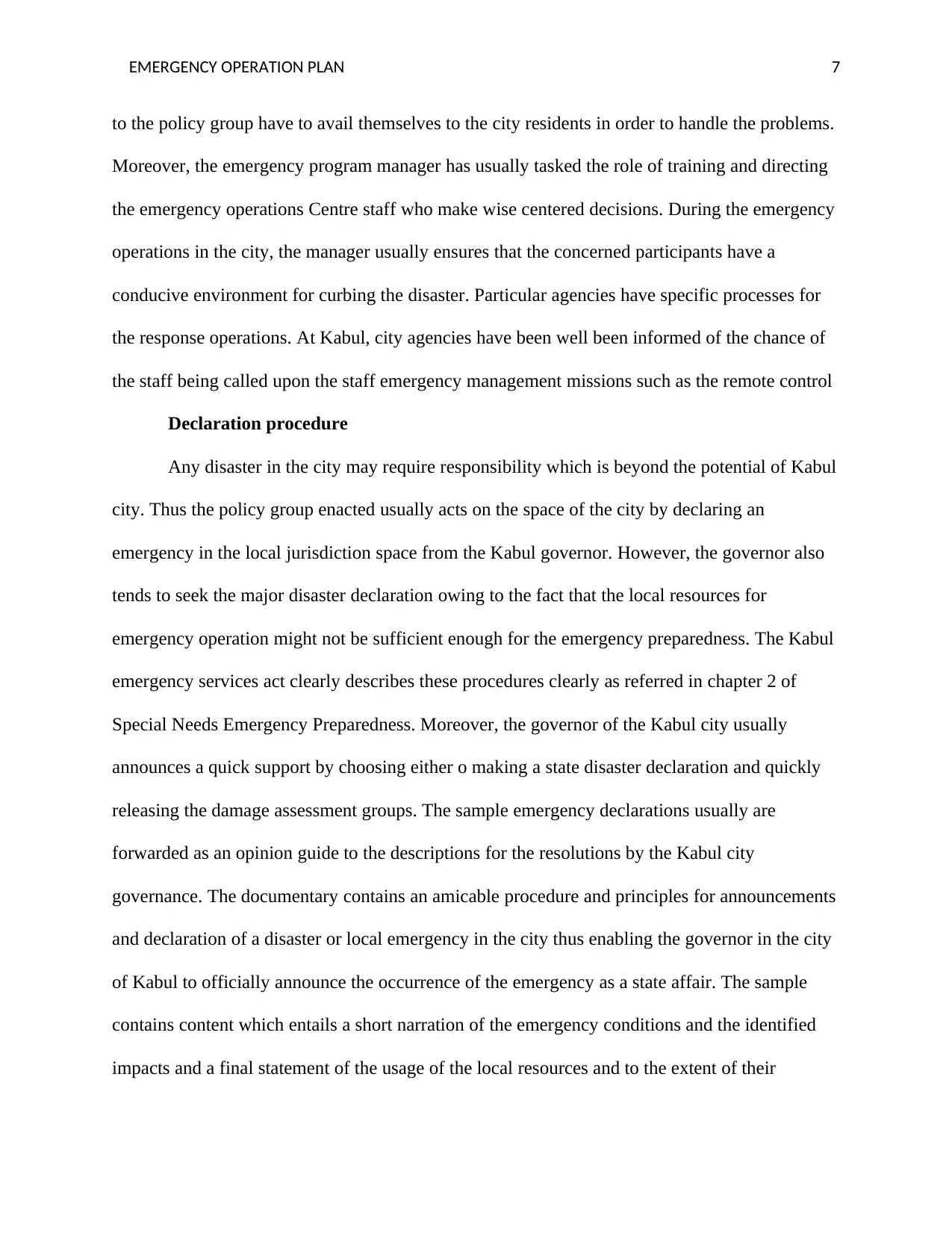
EMERGENCY OPERATION PLAN 7
to the policy group have to avail themselves to the city residents in order to handle the problems.
Moreover, the emergency program manager has usually tasked the role of training and directing
the emergency operations Centre staff who make wise centered decisions. During the emergency
operations in the city, the manager usually ensures that the concerned participants have a
conducive environment for curbing the disaster. Particular agencies have specific processes for
the response operations. At Kabul, city agencies have been well been informed of the chance of
the staff being called upon the staff emergency management missions such as the remote control
Declaration procedure
Any disaster in the city may require responsibility which is beyond the potential of Kabul
city. Thus the policy group enacted usually acts on the space of the city by declaring an
emergency in the local jurisdiction space from the Kabul governor. However, the governor also
tends to seek the major disaster declaration owing to the fact that the local resources for
emergency operation might not be sufficient enough for the emergency preparedness. The Kabul
emergency services act clearly describes these procedures clearly as referred in chapter 2 of
Special Needs Emergency Preparedness. Moreover, the governor of the Kabul city usually
announces a quick support by choosing either o making a state disaster declaration and quickly
releasing the damage assessment groups. The sample emergency declarations usually are
forwarded as an opinion guide to the descriptions for the resolutions by the Kabul city
governance. The documentary contains an amicable procedure and principles for announcements
and declaration of a disaster or local emergency in the city thus enabling the governor in the city
of Kabul to officially announce the occurrence of the emergency as a state affair. The sample
contains content which entails a short narration of the emergency conditions and the identified
impacts and a final statement of the usage of the local resources and to the extent of their
to the policy group have to avail themselves to the city residents in order to handle the problems.
Moreover, the emergency program manager has usually tasked the role of training and directing
the emergency operations Centre staff who make wise centered decisions. During the emergency
operations in the city, the manager usually ensures that the concerned participants have a
conducive environment for curbing the disaster. Particular agencies have specific processes for
the response operations. At Kabul, city agencies have been well been informed of the chance of
the staff being called upon the staff emergency management missions such as the remote control
Declaration procedure
Any disaster in the city may require responsibility which is beyond the potential of Kabul
city. Thus the policy group enacted usually acts on the space of the city by declaring an
emergency in the local jurisdiction space from the Kabul governor. However, the governor also
tends to seek the major disaster declaration owing to the fact that the local resources for
emergency operation might not be sufficient enough for the emergency preparedness. The Kabul
emergency services act clearly describes these procedures clearly as referred in chapter 2 of
Special Needs Emergency Preparedness. Moreover, the governor of the Kabul city usually
announces a quick support by choosing either o making a state disaster declaration and quickly
releasing the damage assessment groups. The sample emergency declarations usually are
forwarded as an opinion guide to the descriptions for the resolutions by the Kabul city
governance. The documentary contains an amicable procedure and principles for announcements
and declaration of a disaster or local emergency in the city thus enabling the governor in the city
of Kabul to officially announce the occurrence of the emergency as a state affair. The sample
contains content which entails a short narration of the emergency conditions and the identified
impacts and a final statement of the usage of the local resources and to the extent of their
Paraphrase This Document
Need a fresh take? Get an instant paraphrase of this document with our AI Paraphraser
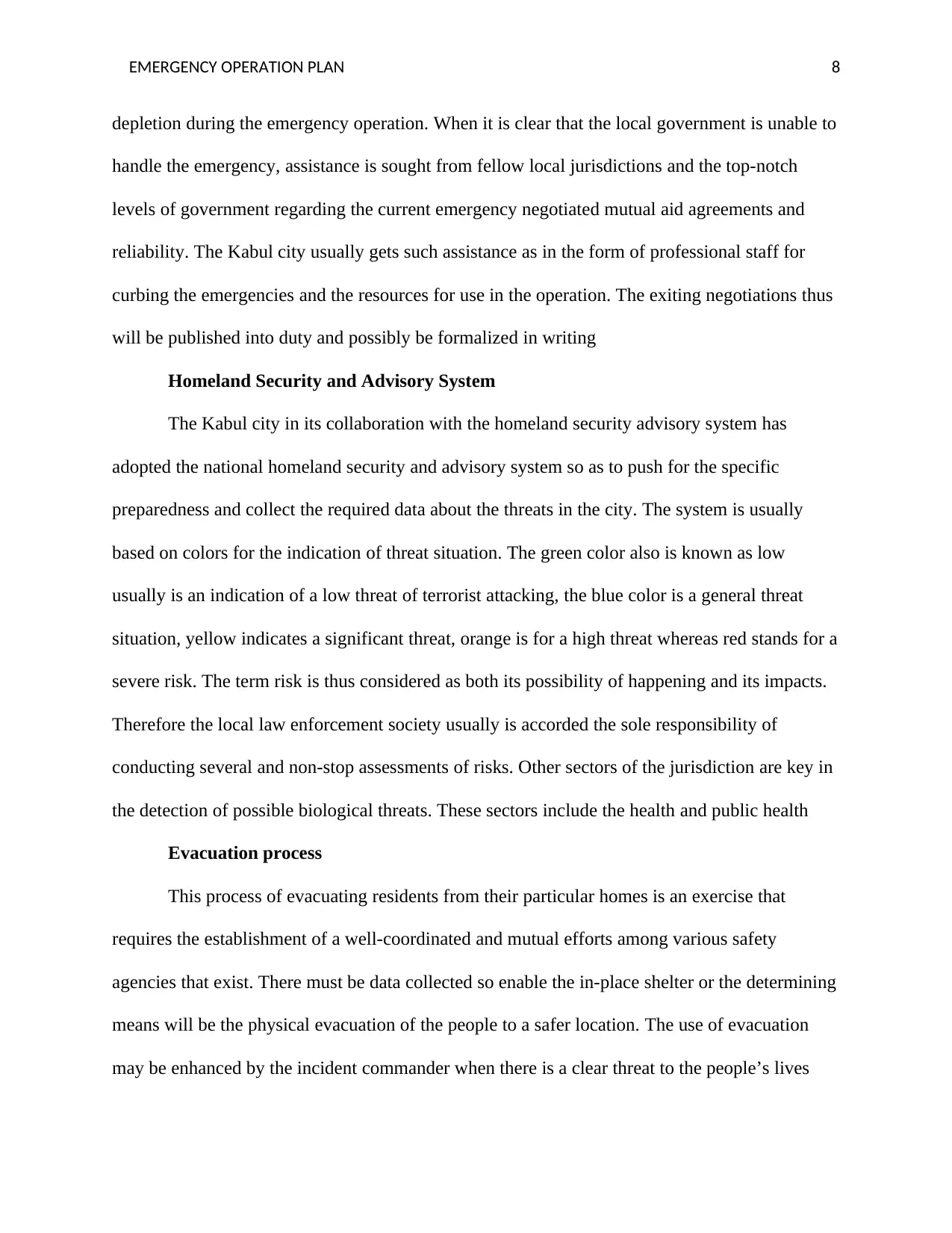
EMERGENCY OPERATION PLAN 8
depletion during the emergency operation. When it is clear that the local government is unable to
handle the emergency, assistance is sought from fellow local jurisdictions and the top-notch
levels of government regarding the current emergency negotiated mutual aid agreements and
reliability. The Kabul city usually gets such assistance as in the form of professional staff for
curbing the emergencies and the resources for use in the operation. The exiting negotiations thus
will be published into duty and possibly be formalized in writing
Homeland Security and Advisory System
The Kabul city in its collaboration with the homeland security advisory system has
adopted the national homeland security and advisory system so as to push for the specific
preparedness and collect the required data about the threats in the city. The system is usually
based on colors for the indication of threat situation. The green color also is known as low
usually is an indication of a low threat of terrorist attacking, the blue color is a general threat
situation, yellow indicates a significant threat, orange is for a high threat whereas red stands for a
severe risk. The term risk is thus considered as both its possibility of happening and its impacts.
Therefore the local law enforcement society usually is accorded the sole responsibility of
conducting several and non-stop assessments of risks. Other sectors of the jurisdiction are key in
the detection of possible biological threats. These sectors include the health and public health
Evacuation process
This process of evacuating residents from their particular homes is an exercise that
requires the establishment of a well-coordinated and mutual efforts among various safety
agencies that exist. There must be data collected so enable the in-place shelter or the determining
means will be the physical evacuation of the people to a safer location. The use of evacuation
may be enhanced by the incident commander when there is a clear threat to the people’s lives
depletion during the emergency operation. When it is clear that the local government is unable to
handle the emergency, assistance is sought from fellow local jurisdictions and the top-notch
levels of government regarding the current emergency negotiated mutual aid agreements and
reliability. The Kabul city usually gets such assistance as in the form of professional staff for
curbing the emergencies and the resources for use in the operation. The exiting negotiations thus
will be published into duty and possibly be formalized in writing
Homeland Security and Advisory System
The Kabul city in its collaboration with the homeland security advisory system has
adopted the national homeland security and advisory system so as to push for the specific
preparedness and collect the required data about the threats in the city. The system is usually
based on colors for the indication of threat situation. The green color also is known as low
usually is an indication of a low threat of terrorist attacking, the blue color is a general threat
situation, yellow indicates a significant threat, orange is for a high threat whereas red stands for a
severe risk. The term risk is thus considered as both its possibility of happening and its impacts.
Therefore the local law enforcement society usually is accorded the sole responsibility of
conducting several and non-stop assessments of risks. Other sectors of the jurisdiction are key in
the detection of possible biological threats. These sectors include the health and public health
Evacuation process
This process of evacuating residents from their particular homes is an exercise that
requires the establishment of a well-coordinated and mutual efforts among various safety
agencies that exist. There must be data collected so enable the in-place shelter or the determining
means will be the physical evacuation of the people to a safer location. The use of evacuation
may be enhanced by the incident commander when there is a clear threat to the people’s lives
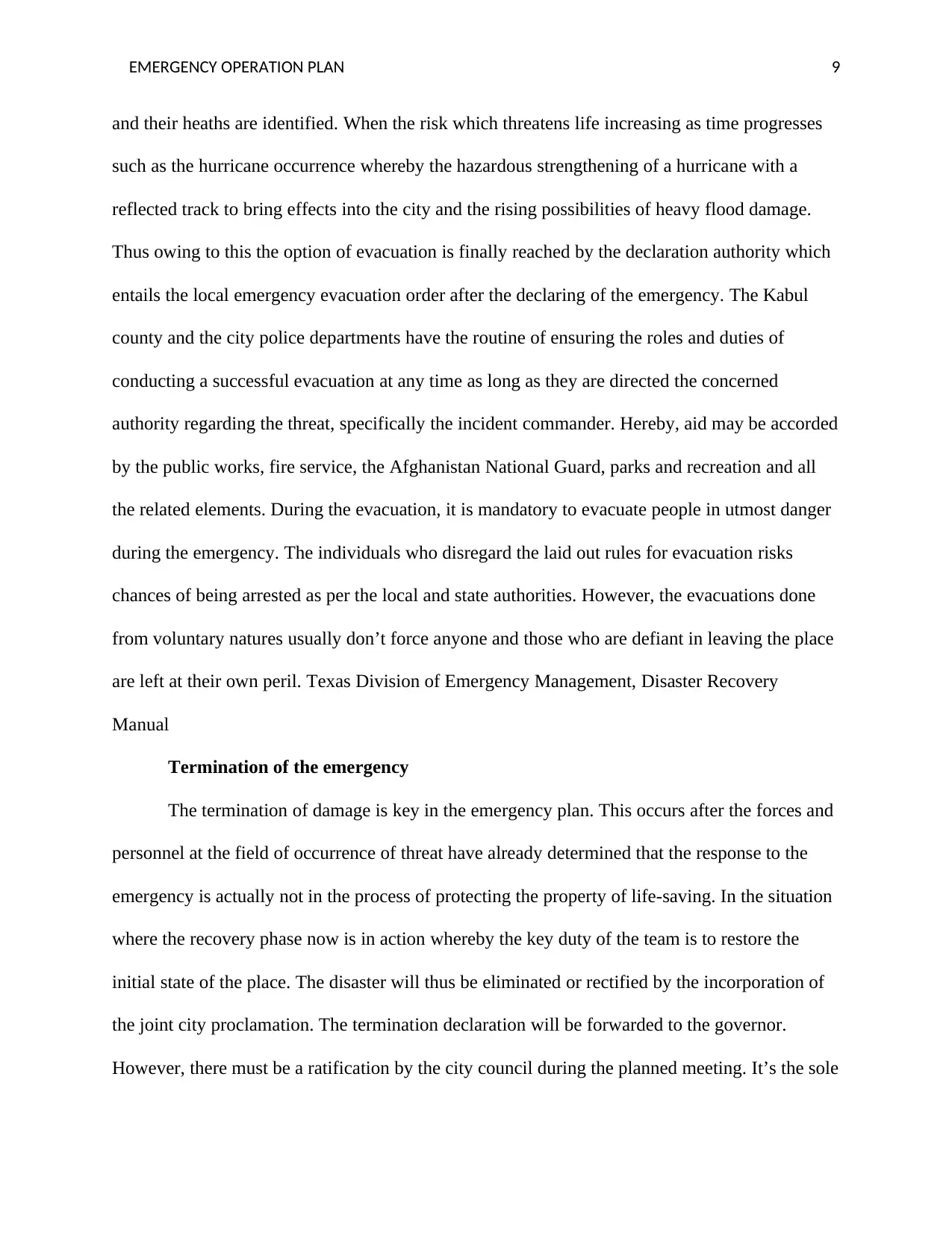
EMERGENCY OPERATION PLAN 9
and their heaths are identified. When the risk which threatens life increasing as time progresses
such as the hurricane occurrence whereby the hazardous strengthening of a hurricane with a
reflected track to bring effects into the city and the rising possibilities of heavy flood damage.
Thus owing to this the option of evacuation is finally reached by the declaration authority which
entails the local emergency evacuation order after the declaring of the emergency. The Kabul
county and the city police departments have the routine of ensuring the roles and duties of
conducting a successful evacuation at any time as long as they are directed the concerned
authority regarding the threat, specifically the incident commander. Hereby, aid may be accorded
by the public works, fire service, the Afghanistan National Guard, parks and recreation and all
the related elements. During the evacuation, it is mandatory to evacuate people in utmost danger
during the emergency. The individuals who disregard the laid out rules for evacuation risks
chances of being arrested as per the local and state authorities. However, the evacuations done
from voluntary natures usually don’t force anyone and those who are defiant in leaving the place
are left at their own peril. Texas Division of Emergency Management, Disaster Recovery
Manual
Termination of the emergency
The termination of damage is key in the emergency plan. This occurs after the forces and
personnel at the field of occurrence of threat have already determined that the response to the
emergency is actually not in the process of protecting the property of life-saving. In the situation
where the recovery phase now is in action whereby the key duty of the team is to restore the
initial state of the place. The disaster will thus be eliminated or rectified by the incorporation of
the joint city proclamation. The termination declaration will be forwarded to the governor.
However, there must be a ratification by the city council during the planned meeting. It’s the sole
and their heaths are identified. When the risk which threatens life increasing as time progresses
such as the hurricane occurrence whereby the hazardous strengthening of a hurricane with a
reflected track to bring effects into the city and the rising possibilities of heavy flood damage.
Thus owing to this the option of evacuation is finally reached by the declaration authority which
entails the local emergency evacuation order after the declaring of the emergency. The Kabul
county and the city police departments have the routine of ensuring the roles and duties of
conducting a successful evacuation at any time as long as they are directed the concerned
authority regarding the threat, specifically the incident commander. Hereby, aid may be accorded
by the public works, fire service, the Afghanistan National Guard, parks and recreation and all
the related elements. During the evacuation, it is mandatory to evacuate people in utmost danger
during the emergency. The individuals who disregard the laid out rules for evacuation risks
chances of being arrested as per the local and state authorities. However, the evacuations done
from voluntary natures usually don’t force anyone and those who are defiant in leaving the place
are left at their own peril. Texas Division of Emergency Management, Disaster Recovery
Manual
Termination of the emergency
The termination of damage is key in the emergency plan. This occurs after the forces and
personnel at the field of occurrence of threat have already determined that the response to the
emergency is actually not in the process of protecting the property of life-saving. In the situation
where the recovery phase now is in action whereby the key duty of the team is to restore the
initial state of the place. The disaster will thus be eliminated or rectified by the incorporation of
the joint city proclamation. The termination declaration will be forwarded to the governor.
However, there must be a ratification by the city council during the planned meeting. It’s the sole
⊘ This is a preview!⊘
Do you want full access?
Subscribe today to unlock all pages.

Trusted by 1+ million students worldwide
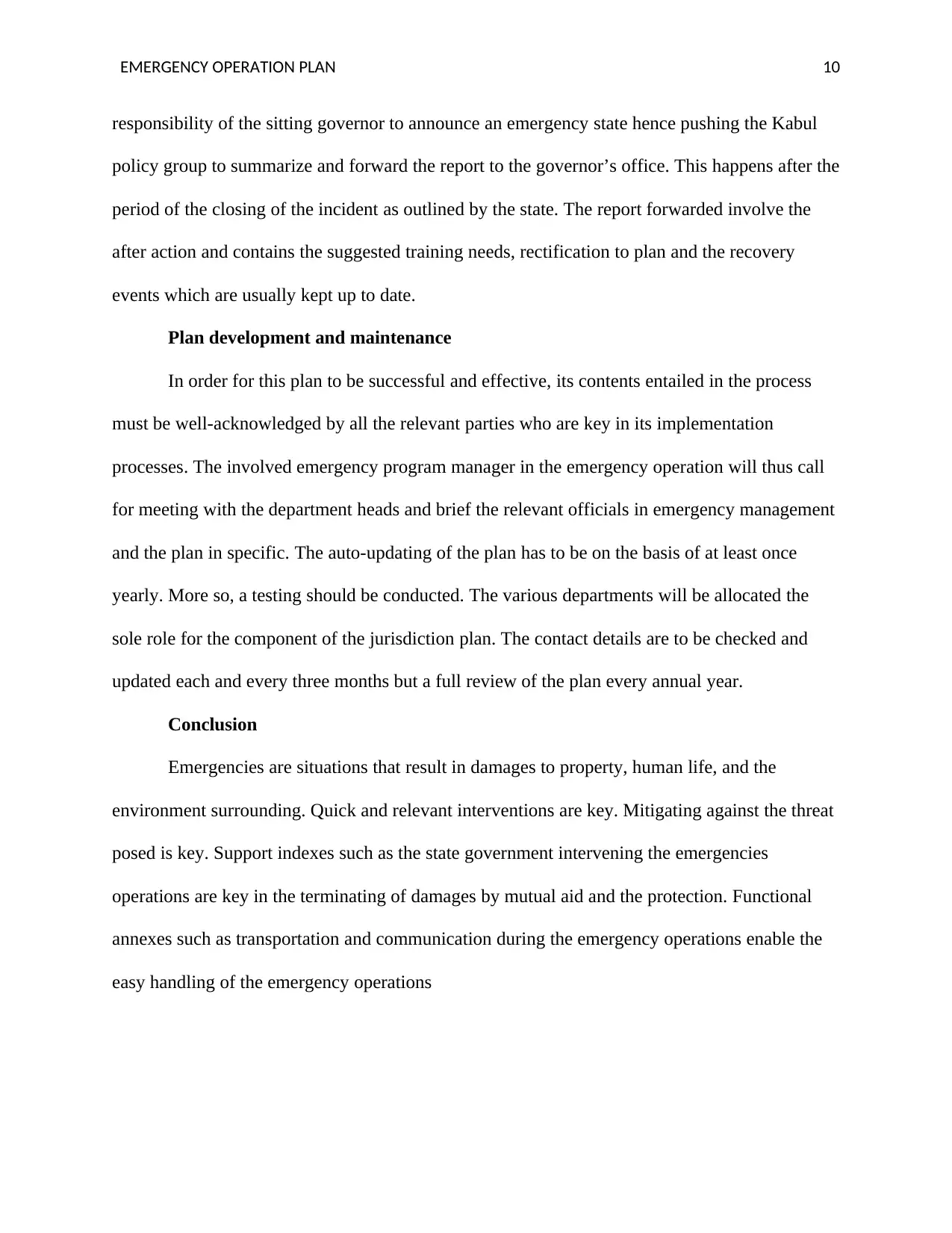
EMERGENCY OPERATION PLAN 10
responsibility of the sitting governor to announce an emergency state hence pushing the Kabul
policy group to summarize and forward the report to the governor’s office. This happens after the
period of the closing of the incident as outlined by the state. The report forwarded involve the
after action and contains the suggested training needs, rectification to plan and the recovery
events which are usually kept up to date.
Plan development and maintenance
In order for this plan to be successful and effective, its contents entailed in the process
must be well-acknowledged by all the relevant parties who are key in its implementation
processes. The involved emergency program manager in the emergency operation will thus call
for meeting with the department heads and brief the relevant officials in emergency management
and the plan in specific. The auto-updating of the plan has to be on the basis of at least once
yearly. More so, a testing should be conducted. The various departments will be allocated the
sole role for the component of the jurisdiction plan. The contact details are to be checked and
updated each and every three months but a full review of the plan every annual year.
Conclusion
Emergencies are situations that result in damages to property, human life, and the
environment surrounding. Quick and relevant interventions are key. Mitigating against the threat
posed is key. Support indexes such as the state government intervening the emergencies
operations are key in the terminating of damages by mutual aid and the protection. Functional
annexes such as transportation and communication during the emergency operations enable the
easy handling of the emergency operations
responsibility of the sitting governor to announce an emergency state hence pushing the Kabul
policy group to summarize and forward the report to the governor’s office. This happens after the
period of the closing of the incident as outlined by the state. The report forwarded involve the
after action and contains the suggested training needs, rectification to plan and the recovery
events which are usually kept up to date.
Plan development and maintenance
In order for this plan to be successful and effective, its contents entailed in the process
must be well-acknowledged by all the relevant parties who are key in its implementation
processes. The involved emergency program manager in the emergency operation will thus call
for meeting with the department heads and brief the relevant officials in emergency management
and the plan in specific. The auto-updating of the plan has to be on the basis of at least once
yearly. More so, a testing should be conducted. The various departments will be allocated the
sole role for the component of the jurisdiction plan. The contact details are to be checked and
updated each and every three months but a full review of the plan every annual year.
Conclusion
Emergencies are situations that result in damages to property, human life, and the
environment surrounding. Quick and relevant interventions are key. Mitigating against the threat
posed is key. Support indexes such as the state government intervening the emergencies
operations are key in the terminating of damages by mutual aid and the protection. Functional
annexes such as transportation and communication during the emergency operations enable the
easy handling of the emergency operations
Paraphrase This Document
Need a fresh take? Get an instant paraphrase of this document with our AI Paraphraser
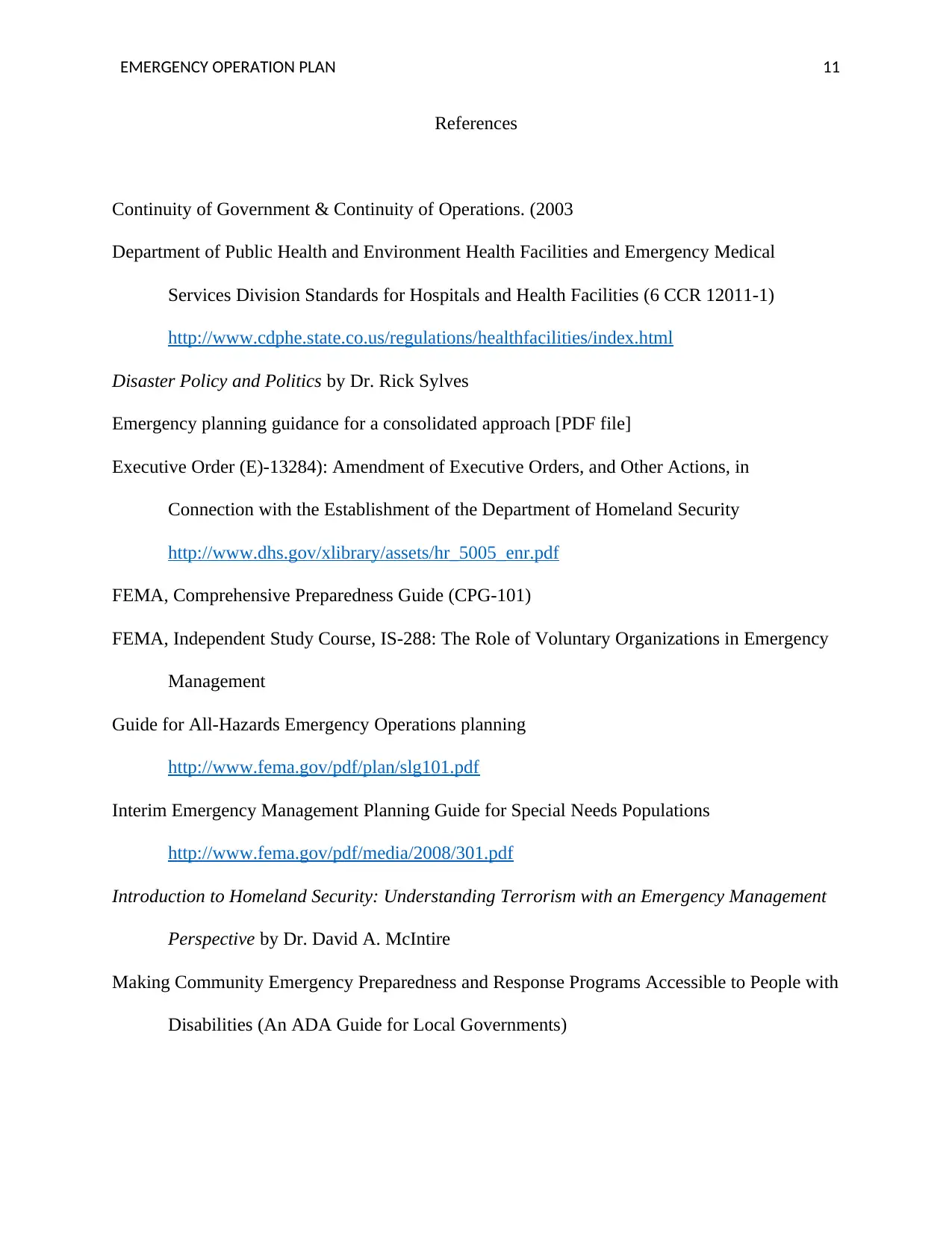
EMERGENCY OPERATION PLAN 11
References
Continuity of Government & Continuity of Operations. (2003
Department of Public Health and Environment Health Facilities and Emergency Medical
Services Division Standards for Hospitals and Health Facilities (6 CCR 12011-1)
http://www.cdphe.state.co.us/regulations/healthfacilities/index.html
Disaster Policy and Politics by Dr. Rick Sylves
Emergency planning guidance for a consolidated approach [PDF file]
Executive Order (E)-13284): Amendment of Executive Orders, and Other Actions, in
Connection with the Establishment of the Department of Homeland Security
http://www.dhs.gov/xlibrary/assets/hr_5005_enr.pdf
FEMA, Comprehensive Preparedness Guide (CPG-101)
FEMA, Independent Study Course, IS-288: The Role of Voluntary Organizations in Emergency
Management
Guide for All-Hazards Emergency Operations planning
http://www.fema.gov/pdf/plan/slg101.pdf
Interim Emergency Management Planning Guide for Special Needs Populations
http://www.fema.gov/pdf/media/2008/301.pdf
Introduction to Homeland Security: Understanding Terrorism with an Emergency Management
Perspective by Dr. David A. McIntire
Making Community Emergency Preparedness and Response Programs Accessible to People with
Disabilities (An ADA Guide for Local Governments)
References
Continuity of Government & Continuity of Operations. (2003
Department of Public Health and Environment Health Facilities and Emergency Medical
Services Division Standards for Hospitals and Health Facilities (6 CCR 12011-1)
http://www.cdphe.state.co.us/regulations/healthfacilities/index.html
Disaster Policy and Politics by Dr. Rick Sylves
Emergency planning guidance for a consolidated approach [PDF file]
Executive Order (E)-13284): Amendment of Executive Orders, and Other Actions, in
Connection with the Establishment of the Department of Homeland Security
http://www.dhs.gov/xlibrary/assets/hr_5005_enr.pdf
FEMA, Comprehensive Preparedness Guide (CPG-101)
FEMA, Independent Study Course, IS-288: The Role of Voluntary Organizations in Emergency
Management
Guide for All-Hazards Emergency Operations planning
http://www.fema.gov/pdf/plan/slg101.pdf
Interim Emergency Management Planning Guide for Special Needs Populations
http://www.fema.gov/pdf/media/2008/301.pdf
Introduction to Homeland Security: Understanding Terrorism with an Emergency Management
Perspective by Dr. David A. McIntire
Making Community Emergency Preparedness and Response Programs Accessible to People with
Disabilities (An ADA Guide for Local Governments)
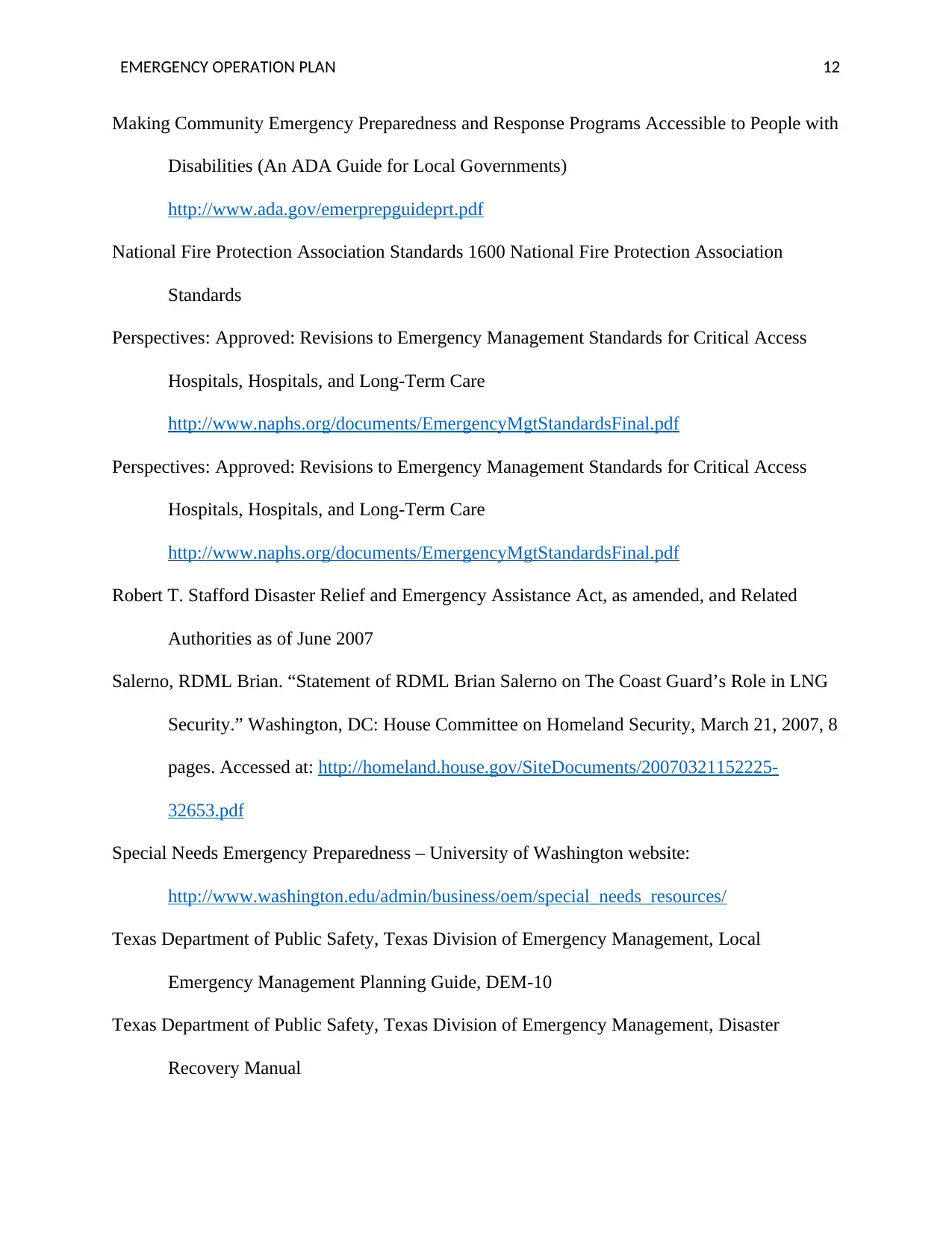
EMERGENCY OPERATION PLAN 12
Making Community Emergency Preparedness and Response Programs Accessible to People with
Disabilities (An ADA Guide for Local Governments)
http://www.ada.gov/emerprepguideprt.pdf
National Fire Protection Association Standards 1600 National Fire Protection Association
Standards
Perspectives: Approved: Revisions to Emergency Management Standards for Critical Access
Hospitals, Hospitals, and Long-Term Care
http://www.naphs.org/documents/EmergencyMgtStandardsFinal.pdf
Perspectives: Approved: Revisions to Emergency Management Standards for Critical Access
Hospitals, Hospitals, and Long-Term Care
http://www.naphs.org/documents/EmergencyMgtStandardsFinal.pdf
Robert T. Stafford Disaster Relief and Emergency Assistance Act, as amended, and Related
Authorities as of June 2007
Salerno, RDML Brian. “Statement of RDML Brian Salerno on The Coast Guard’s Role in LNG
Security.” Washington, DC: House Committee on Homeland Security, March 21, 2007, 8
pages. Accessed at: http://homeland.house.gov/SiteDocuments/20070321152225-
32653.pdf
Special Needs Emergency Preparedness – University of Washington website:
http://www.washington.edu/admin/business/oem/special_needs_resources/
Texas Department of Public Safety, Texas Division of Emergency Management, Local
Emergency Management Planning Guide, DEM-10
Texas Department of Public Safety, Texas Division of Emergency Management, Disaster
Recovery Manual
Making Community Emergency Preparedness and Response Programs Accessible to People with
Disabilities (An ADA Guide for Local Governments)
http://www.ada.gov/emerprepguideprt.pdf
National Fire Protection Association Standards 1600 National Fire Protection Association
Standards
Perspectives: Approved: Revisions to Emergency Management Standards for Critical Access
Hospitals, Hospitals, and Long-Term Care
http://www.naphs.org/documents/EmergencyMgtStandardsFinal.pdf
Perspectives: Approved: Revisions to Emergency Management Standards for Critical Access
Hospitals, Hospitals, and Long-Term Care
http://www.naphs.org/documents/EmergencyMgtStandardsFinal.pdf
Robert T. Stafford Disaster Relief and Emergency Assistance Act, as amended, and Related
Authorities as of June 2007
Salerno, RDML Brian. “Statement of RDML Brian Salerno on The Coast Guard’s Role in LNG
Security.” Washington, DC: House Committee on Homeland Security, March 21, 2007, 8
pages. Accessed at: http://homeland.house.gov/SiteDocuments/20070321152225-
32653.pdf
Special Needs Emergency Preparedness – University of Washington website:
http://www.washington.edu/admin/business/oem/special_needs_resources/
Texas Department of Public Safety, Texas Division of Emergency Management, Local
Emergency Management Planning Guide, DEM-10
Texas Department of Public Safety, Texas Division of Emergency Management, Disaster
Recovery Manual
⊘ This is a preview!⊘
Do you want full access?
Subscribe today to unlock all pages.

Trusted by 1+ million students worldwide
1 out of 13
Related Documents
Your All-in-One AI-Powered Toolkit for Academic Success.
+13062052269
info@desklib.com
Available 24*7 on WhatsApp / Email
![[object Object]](/_next/static/media/star-bottom.7253800d.svg)
Unlock your academic potential
Copyright © 2020–2025 A2Z Services. All Rights Reserved. Developed and managed by ZUCOL.





